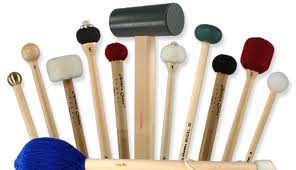One of the most important musical choices a percussionist makes—regardless of the instrument—is mallet selection. Selecting the most appropriate mallet for a passage makes all the difference but with the hundreds of mallets available, how does one make this choice. Here are some principals that I use that may help other percussionists, conductors, and music educators in the selection of mallets.

Principals
• Strive to make the best possible sound, no matter the instrument, the musical style or the environment. Quality of sound is foremost.
• A harder mallet produces greater articulation with a brighter, more abrasive tone. A softer mallet produces less clarity of articulation with a warmer, richer the tone.
• Dynamic volume is not determined by the hardness of the mallet in most cases. However, a stronger attack may be perceived as louder.
• A larger membrane or surface requires a larger, more massive mallet and a smaller membrane or surface requires a smaller mallet with less mass.
• An improper choice and/or use of mallets will produce a poor quality sound and can damage the instrument.
• There is no one, perfect mallet for every player, every instrument and/or every piece of music. Always be sensitive to the musical style and quality of sound.
• Creativity and sensitivity must be used when choosing the proper mallet to create the desired color from the instrument.
• Don’t hesitate to experiment and try something new.
When deciding on a mallet choice within a musical selection, one must be aware of these aspects:
• is the musical role of the part more rhythmic, melodic, or harmonic?
• is the musical role soloistic or supportive?
• should the desired sound blend or contrast with the other instruments?
• how much projection is needed and/or desired?
• what mallet choice is indicated by the composer/arranger and is it the best choice? At times, what is asked for is not the best choice for a quality sound.
• don’t accept a poor quality of sound due to a lack of mallet selection. Any great artist, craftsman or athlete has the proper tools to do the job (i.e. painter, carpenter, plumber, golfer, cyclist)
By combining all of these ideas, correct choices can be made regarding mallet selection that will produce a beautiful sound that is integral to the musical selection while maintaining the life of the instrument.
Remember: Be SENSITIVE, Be CREATIVE, Be EXCITED!
©2013, David L. Collier

David Collier is Director of Percussion and oversees all aspects of percussion at Illinois State University. In addition he is webmaster for the School of Music. He is principal timpanist with the Illinois Symphony Orchestra, Illinois Chamber Orchestra and the Peoria Symphony Orchestra. Dr. Collier is also active as a freelance percussionist and has performed with artists such as Mitzi Gaynor, Henry Mancini, Johnny Mathis, Tony Bennett, Petula Clark, Aretha Franklin, Tommy Tune, Roger Williams, Shirley Jones, and Bobby Vinton. Dr. Collier received his Bachelor of Music degree from Florida State University, his Master of Music degree from Indiana University–where he was awarded a Performer’s Certificate–and his doctorate in Percussion Performance and Electronic Music from the University of Illinois. His teachers include Gary Werdesheim, George Gaber, Barry Jekowsky, Richard Holmes, Thomas Siwe, William Moersch, and Scott Wyatt.

Leave a Reply